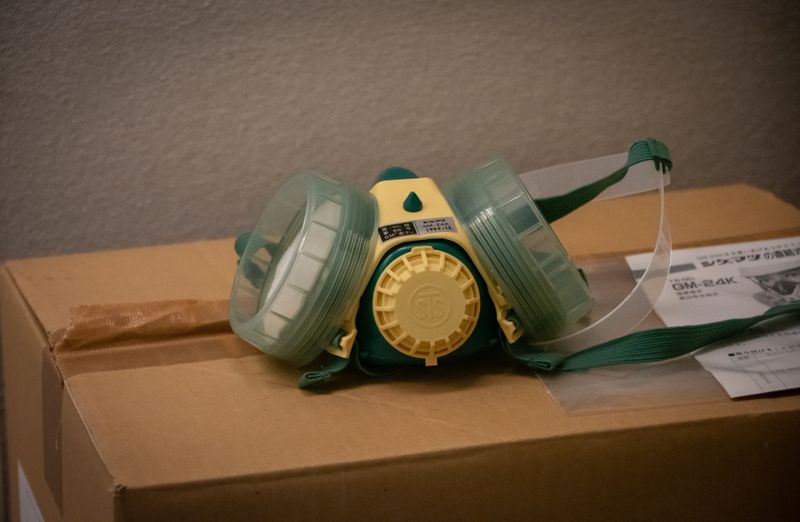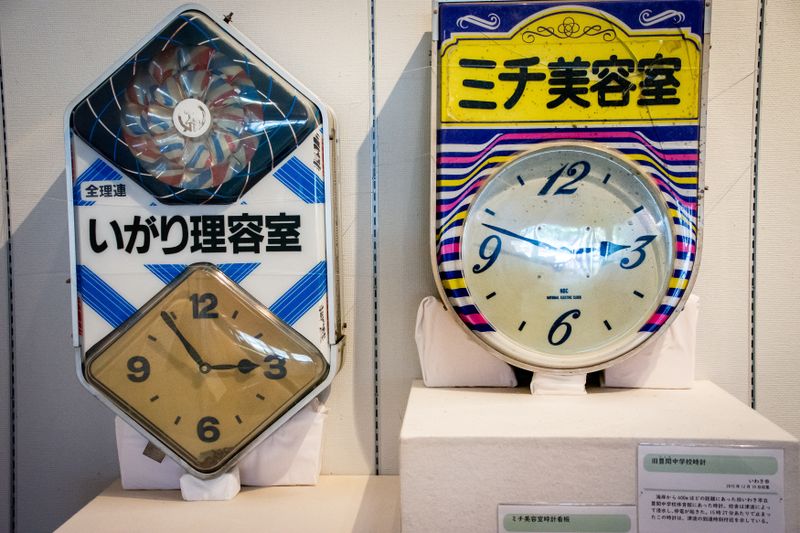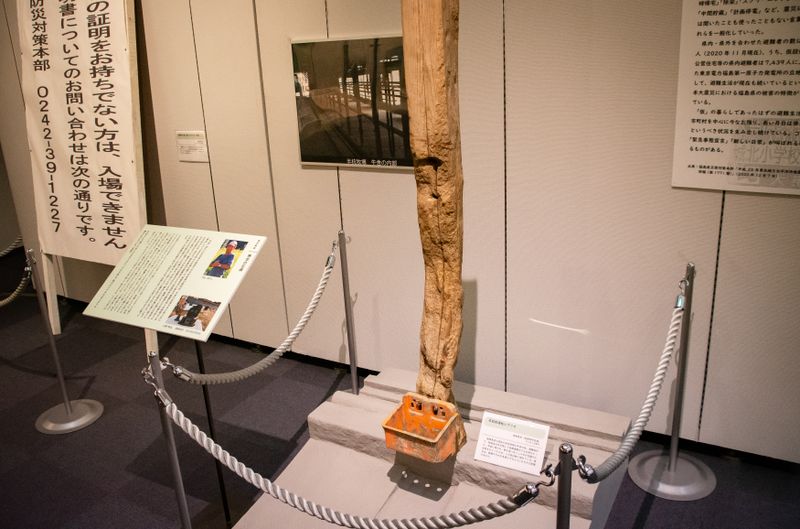Mar 12, 2021
10th anniv. exhibition unearths symbols of hope from 2011 disaster heritage

Around the 10th anniversary of the Great East Japan Earthquake and subsequent nuclear disaster, curators of a special exhibition in the city of Aizuwakamatsu, Fukushima Prefecture, are displaying disaster-related items as important heritage and symbols of hope.
Upon entering the special 10-year anniversary exhibition at the prefecture-run Fukushima Museum visitors may be arrested by the sight of stopped clocks, hands frozen in time around the time of the earthquake.
The display is perhaps an all-too-familiar one but nonetheless served its purpose, in this visitor at least, as a stark reminder of when around 10 years ago time appeared to stand still even when the world around was moving toward a chaotic and devastating end for so many.
The clocks may have stopped but the brutal truth that time hasn’t serves to remind of the race against time facing efforts to record and preserve disaster-related items such that lessons might be learned and passed onto future generations, something which the museum hopes to do with its special exhibition - “Thinking about disaster heritage: Connecting to the next 10 years.”

(Clocks stopped around the time of the Great East Japan Earthquake on March 11, 2011)
Museum curators officially began to record and collect disaster-related items in 2014 with the museum having since hosted smaller exhibitions about the disaster. According to Tadasuke Tsukuba, a curator at the museum, some of the items were actually collected just a month after the earthquake.
“We are working as a group of eight. Some of us had this realization just after the earthquake of the need to preserve items in order to keep some kind of legacy,” Tsukuba said during an interview at the museum in February.
“For the rest of us, we gradually noticed that after seeing items removed as a result of the on-going reconstruction efforts we needed to keep these items for the future. In the case of areas damaged by the tsunami, the tsunami itself removed many items so not much was left. For the regions in Fukushima affected by the nuclear disaster, items were left behind so we were able to preserve them.”
Of these items, some 170 are on display across three areas in a larger-scale exhibition to mark the 10th anniversary of the disaster.
In the first area museum curators aim at delivering the kind of visual impact that enables exhibition visitors to get an early grasp of the scale of events of 10 years ago. Along with the stopped clocks, a section of JR Joban Line railway tracks, found in the city of Tomioka in Fukushima Prefecture, damaged by the tsunami is displayed.
Eyes are also drawn to a deformed wooden pillar. The pillar is a replica of one found in a barn belonging to dairy farmer Issei Hangui whose farm in the city of Minamisoma, located within 20 km of the Fukushima Daiichi Nuclear Power Plant, had to be evacuated.
According to news reports published around the time of his return to the farm, Hangui was forced to leave behind 40 dairy cows, 34 of which were believed to have starved to death, but not before apparently gnawing at the lower half of the pillar in a desperate attempt to take in food.

(Replica of a pillar gnawed away by cows at an evacuated dairy farm in Minamisoma, Fukushima Prefecture)
The second area of the exhibition displays items which curators felt offer insight into the situation on the ground during the aftermath of the disaster. Among the exhibits is a reproduction of the main table of the disaster response headquarters in Tomioka City, Fukushima Prefecture. Memos left on the table mention cars washed away by the tsunami and the situation at the nuclear power plant.
Another of the exhibits is a poster collected in April 2011 entitled “Minna no Yume” (Our Dreams) created by children in their final class at Kyu-Soma Girls School (旧相馬女子高校) in the city of Soma. The school was used as an evacuation shelter in the aftermath of the disaster, with spare rooms given over to the teaching of children before they were eventually able to return to their respective schools.
With the children having been invited to write their dreams for the future museum curators draw attention to the simple, more immediate nature of the messages -- the desire to see friends, to return home -- rather than the far-reaching dreams typical of young minds. It’s an exhibit which Tsukuba finds particularly touching.
“I didn’t experience events at that time directly. I was involved in support efforts. Initially, I didn’t have any particularly strong feelings when interacting with the items in this exhibit,” he said.
“However, from around two years ago we began interviewing people connected with the items we are preserving here. While doing these interviews I began thinking about how important these items are and how they should be respected.”
Indeed, for the final area of the exhibition curators have chosen to display those items which had made them aware of the importance of preserving such items in the first place.
“I think people forget easily. In particular, if people didn’t have first-hand experience of this incident, they may not continue thinking so deeply about it. This is one of the purposes of the exhibition -- to give people cause again to think about the events of 10 years ago.”
Not that the cause has always been welcomed.
“There are some people who have said that they don’t want to see this exhibition. They feel it would be too hard. I also think that some people may feel that their own experience has been even worse than those that are portrayed through the exhibits here so maybe it has no meaning for them,” Tsukuba said when asked about visitor feedback.
Those who are able though, are also invited to consider how the events of 10 years ago and the heritage being curated as a result might shape any outlook for the coming decade, stirring powerful emotions in some.
“Some visitors remember the events at that time and it makes them cry. They have left thinking that we should never forget what happened, that this exhibition has to be continued,” Tsukuba continued.
Not everyone is thinking on a 10-year timescale, however.
For Japan’s Reconstruction Agency, established within the Cabinet in Feb. 2012, the 10th anniversary of the disaster marks the end of the five-year first term of the agency’s “reconstruction and revitalization period” (following a four-year “intensive reconstruction period”).
During these periods the number of people forced to relocate as a result of the disaster has decreased from 470,000 to 42,000 (as of Dec. 2020), housing reconstruction has largely been completed, and production levels in three disaster-affected prefectures have almost recovered to pre-disaster levels, according to information published by the agency in January this year.
FY 2021 will mark the first year of the agency’s second reconstruction and revitalization period for which approximately 1.6 trillion yen has been earmarked to cover related projects through FY 2025.
Such data might appear to paint a picture of a rapidly-changing post-disaster landscape, one which may eventually lead to the creation of what the agency has called “a new Tohoku,” a vision of communities revitalized even from a state of pre-disaster depopulation through disaster reconstruction.
In the meantime though, as long as people are still living in temporary housing unable to return to their homes, the process of recording and curating disaster heritage remains on-going, according to Tsukuba.
“It’s the same with clean-up work on the nuclear power plant which is still on-going. Items are still being recovered and preserved because of these situations.”
“As a museum, of course, we could choose to discard them, but if there are items we can keep now then we should do that, to save them for future generations, and then they can decide whether or not to keep them.”
Museum curators seem to be acutely aware of the opposing forces and emotions that surround the exhibition -- the desire to move on but not to forget, the need to rebuild and the urge to preserve. Dreams of a return to the old life in a new Tohoku.
Nowhere is this captured better in the exhibition than in its final item -- a simple display of an endangered species of flowering plant found growing on land swept by the tsunami.
“It occupies a space between human society and nature, so we saw it as symbolizing the theme of this exhibition and something to make us think about our lives,” Tsukuba said.
“The plant looked like a symbol of hope but at the same time reconstruction could see it removed.”
Hope, but of a fragile kind then.
“Gradually evacuees, people directly affected (by the disaster) are coming to terms with their new life,” Tsukaba said.
“Speaking to these people I got the sense that while they can’t clearly see what it is they are hoping for they have finally started to gain that hope, a sense that something better is just around the corner.”
The exhibition “Thinking about disaster heritage: Connecting to the next 10 years” runs through March 21, 2021 at the Fukushima Museum in central Aizuwakamatsu City, near to the city’s iconic Tsuruga Castle.
From 2014 to 2016 the Fukushima Museum was involved with the "Fukushima Earthquake Heritage Conservation Project,” a collaboration between museums and study groups in Fukushima Prefecture sharing information about events that occurred in the wake of the Great East Japan Earthquake and subsequent nuclear disaster through exhibitions and outreach programs, among other initiatives.
Since 2017 the museum has continued to record and curate disaster-related items as an independent project of the facility.



0 Comments